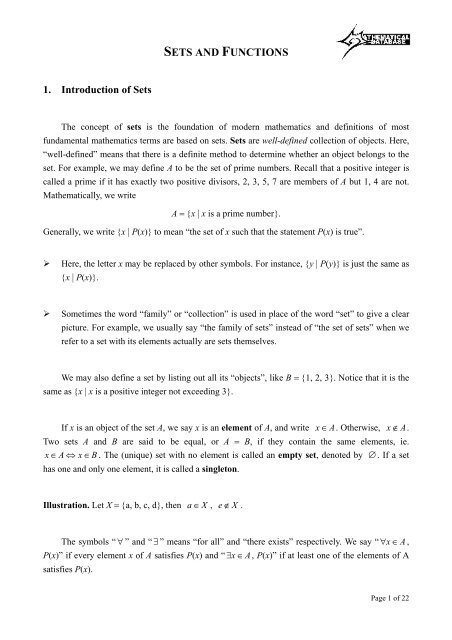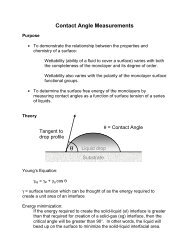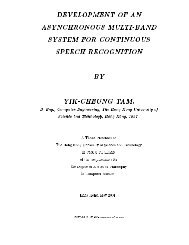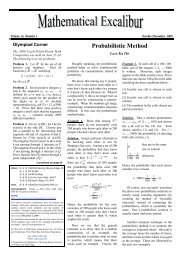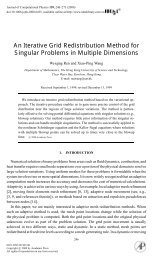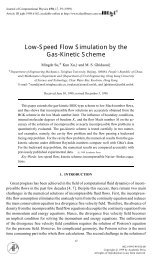SETS AND FUNCTIONS
SETS AND FUNCTIONS
SETS AND FUNCTIONS
- No tags were found...
Create successful ePaper yourself
Turn your PDF publications into a flip-book with our unique Google optimized e-Paper software.
<strong>SETS</strong> <strong>AND</strong> <strong>FUNCTIONS</strong>Mathematical Database1. Introduction of SetsThe concept of sets is the foundation of modern mathematics and definitions of mostfundamental mathematics terms are based on sets. Sets are well-defined collection of objects. Here,“well-defined” means that there is a definite method to determine whether an object belongs to theset. For example, we may define A to be the set of prime numbers. Recall that a positive integer iscalled a prime if it has exactly two positive divisors, 2, 3, 5, 7 are members of A but 1, 4 are not.Mathematically, we writeA = {x | x is a prime number}.Generally, we write {x | P(x)} to mean “the set of x such that the statement P(x) is true”.‣ Here, the letter x may be replaced by other symbols. For instance, {y | P(y)} is just the same as{x | P(x)}.‣ Sometimes the word “family” or “collection” is used in place of the word “set” to give a clearpicture. For example, we usually say “the family of sets” instead of “the set of sets” when werefer to a set with its elements actually are sets themselves.We may also define a set by listing out all its “objects”, like B = {1, 2, 3}. Notice that it is thesame as {x | x is a positive integer not exceeding 3}.If x is an object of the set A, we say x is an element of A, and write x∈ A. Otherwise, x∉ A.Two sets A and B are said to be equal, or A = B, if they contain the same elements, ie.x∈A⇔ x∈ B. The (unique) set with no element is called an empty set, denoted by ∅ . If a sethas one and only one element, it is called a singleton.Illustration. Let X = {a, b, c, d}, then a∈ X , e∉ X .The symbols “∀ ” and “ ∃ ” means “for all” and “there exists” respectively. We say “ ∀x∈ A,P(x)” if every element x of A satisfies P(x) and “ ∃x∈A, P(x)” if at least one of the elements of Asatisfies P(x).Page 1 of 22
Mathematical DatabaseIllustration. Let Y = {1, 3, 5, 7, 9}, then ∀x∈ Y , x is odd. Also, ∃x∈Y such that x is a composite.For any sets A and B, if ∀x∈ A, x∈B, i.e. B contains all the elements of A, then A is said tobe a subset of B, denoted by A⊆B. Furthermore, if there is an element of B not in A, A is called aproper subset of B. Clearly, A = B if and only if A⊆ B and B⊆A. This property is useful inproving that two sets are equal.In convenience, we usually denote the set of natural numbers by , the set of integers by ,the set of rational numbers by , the set of real numbers by , and the set of complex numbersby . Clearly, ⊆⊆⊆⊆. The positive-element subset of , , are + ,+ respectively.+ ,‣ There is still no standard agreement on the set of natural numbers. Some regard it as the set ofpositive integers, while the other regard it as the set of non-negative integers. For the rest ofthe text, we adopt the first definition.‣ We may denote the subset of a set A whose elements satisfied the statement P by{ x∈ A| P( x)}.Example 1.1.Prove that {x | x is a triangle with every interior angle not smaller than 60 } is equal to the set ofequilateral triangles.Solution.Let A be the set of triangles with every interior angle not smaller than 60 , B be the set ofequilateral triangles. Since the three interior angles of any equilateral triangle is 60 , every elementof B satisfies the statement “a triangle with every interior angle not smaller than 60 ”. Therefore,∀x∈ B, x∈ A, i.e. B⊆ A.On the other hand, suppose x∈ A , Let θ 1, θ2, θ3be the three interior angles, with60 ≤θ1 ≤θ2 ≤θ3. Since 60 ≤ θ3 = 180 −θ1−θ2≤180 −60 − 60 = 60 , we get θ = θ = θ = 60 .1 2 3Therefore x∈ B. Hence A⊆B. The proof is completed.Page 2 of 22
n∪ Ai= {x | x is an element of at least oneii=1A }.Mathematical DatabaseThe intersection of them, denoted by A 1∩A 2∩... ∩ An, or simply∩ni=1A , isin∩ Ai= {x | x Aii=1∈ for all i = 1, 2, …, n}.Here are some more properties about intersection and union of sets. Although trivial, they maybe useful. The readers may try to verify them.Theorem 2.2.Let A, B, C be sets, then1. ∅⊆ A;2. A∪∅= A;3. A∩∅=∅;4. A⊆ A∪ B;5. B⊆ A∪ B;6. A∩B⊆ A;7. A∩B⊆ B;8. A⊆ B, B⊆C ⇒ A⊆ C.Let A, B be sets. The complement of B relative to A, denoted by A\B, or A−B, is the set{ x| x∈A and x∉ B}.+Illustration. \ is the set of non-positive integer, \ is the set of irrational number.In any discussion involving sets, we call the set consisting of all elements under discussion tobe the universal set, and is usually denoted by U. If such a set exists and A⊂U , we may denotethe set U \ A by A C . In using this notation, we must make sure that the set U is clear and wouldnot cause confusion to readers.Theorem 2.3.Let A, B be sets, and U is the universal set. Then1.CA∪ A = U ;C2. A∩A =∅;3. ( C CA ) = A;C4. A\B= A∩ B .Page 4 of 22
It is easy to prove theorem 2.3, so we shall not give a proof.Mathematical DatabaseTheorem 2.4. (De Morgan’s theorem)Let A, B, C be sets. Then1. A\ ( B∪ C) = ( A\ B) ∩ ( A\ C);2. A\( B∩ C) = ( A\ B) ∪ ( A\ C).Proof. (1) is true becausex∈A\ ( B∪C) ⇔ x∈A and x∉B∪C⇔ x∈A and ( x∉B and x∉C)⇔ x∈A\ B and x∈A\C⇔ x∈( A\ B) ∩( A\ C)Similarly, for (2), it is becausex∈A\ ( B∩C) ⇔ x∈A and x∉B∩C⇔ x∈A and ( x∉B or x∉C)⇔( x∈A and x∉B) or ( x∈A and x∉C)⇔ x∈A\ B or x∈A\C⇔ x∈( A\ B) ∪( A\ C)Q.E.D.‣ From theorem 2.4, we immediately get ( X ∪ Y) C = X C ∩ YC and ( X ∩ Y) C = X C ∪ YC ,special cases of them.Definition 2.1. (Intervals)Let ab∈ , , with a< b. Then we define1. ( ab , ) = { x∈ | a< x
Mathematical Databaserespectively. They may be considered as “numbers” beyond the real number system such that forany real number x, −∞ < x < ∞ . Notice that neither of them belongs to . We may replace a by−∞ and b by ∞ in open interval or half open intervals in definition 2.1 to represent unbounded+intervals. For instances, ( −∞, ∞ ) = , (0, ∞ ) = .‣ It is incorrect to write (1, ∞ ], [ −∞ ,0) to denote intervals in since ∞−∞∉ , .Definition 2.2. (Power Set)Let A be a set, then we define the power set of A to be the set of all subsets of A, denoted by P(A).Symbolically, we write P(A) = {x | x⊆ A}.‣ Note that ∅⊆ A for any set A. Indeed, P( ∅ ) = { ∅ } is not empty.‣ In general, A⊆ P( A)is false, except when A =∅.Illustration. Let A = {0, 1, a}, then P(A) = {∅ ,{0}, {1}, {a}, {0, 1}, {0, a}, {1, a}, A}For any sets A and B, we define their Cartesian product A× B to be the set of all orderedpairs (a, b) with a∈ A, b∈ B. Shortly, A× B= {( a, b) | a∈A and b∈ B}. In general, we mayextend the definition to n arbitrary sets A1, A2, … , An, withA × A × ... × A = {( a , a ,..., a ) | a ∈ A for i= 1,2,..., n}.1 2 n 1 2 n i iIf A1 = A2 = ... = An= A, we can simply writenA instead.Illustration. Let A = {1, 2, 3}, B = {a, b}. ThenA× B={(1,a),(1,b),(2,a),(2,b),(3,a),(3,b)}Illustration. (1, 2, 3) and (2, 1, 3) are two distinct elements of3 .3. FunctionsDefinition 3.1. (Function)Let A, B be non-empty sets. Then a function (mapping) f from A to B, denoted by f : A→Brule that associates each element a in A a unique element b in B. We say that f maps a into b, andwrite f(a) = b.Here, A is called the domain, and B is called the codomain of f. b is called the image of a, and a isa pre-image of b under f., is aPage 6 of 22
Mathematical Database‣ If the codomain is or , f is said to be a real-valued function or a complex-valuedfunction respectively.Illustration. Let f : →, defined by f( x) ( 1) x xthere exists an unique element y ∈ such that y = ( − 1) x x. For example,= − . It is well-defined since for every x ∈ ,3f (3) = ( −1) ⋅ 3 =− 3 .Illustration. If we let g : →, but with gx ( ) = x/ 3, then g is not well-defined. For instance, 1is an element of the domain, , but there does not exist an element y from the codomain, also ,such that y = 1/ 3 .Sometimes, a function would be defined according to definition 3.2.Definition 3.2. (Function, in terms of sets)Let A, B be non-empty sets. Then a function f is a subset of A× B, which satisfies1. ∀a∈ A, ∃b∈ B such that ( ab , ) ∈ f;2. If ( ab , ),( ab , ') ∈ f, then b= b'.We write f(a) = b if ( ab , )∈ f.Readers should have already noted that the two conditions in definition 3.2 is actuallycorresponding to the words “each” and “unique” in the phase “associates each element a in A aunique element b in B” in definition 3.1 respectively. Indeed, the difference in the two definitions isjust a matter of presentation only.Definition 3.3. (Equality of functions)Let f : A→ B, g:A→ B be functions, then we say f equal to g, denoted by f = g , iff( x) = g( x) for all x in A.Definition 3.4. (Direct Image, Inverse Image and Range of a function)Let f : A→ B be a function, then for any X ⊆ A, we define the direct image of X under f, f(X),to bef( X) = { b∈ B| b= f( x) for some x∈ X}.For any Y ⊆ B,we define the inverse image of Y under f,−f 1 ( Y) = { a∈A| f( a) ∈ Y}.f1 ( Y), to beIn particular, we define the range of f, denoted by R(f ), to be f(A). That isR( f) = { b∈ B| b= f( a) for some a∈ A}.−Page 7 of 22
Definition 3.5. (Composition of Functions)Let f : A→ B , g:C → D be functions. If B⊂Cg f : A→D byg f( x) = g( f( x)).Mathematical Database, we define the composite functionIllustration. Let f : ( ) ( ( )) (| |) | | .2g f x = g f x = g x = x = x⋅x→ , g : → be functions defined by f( x) = | x|,gx ( )2= x, then‣ In general, g f ≠ f g.Theorem 3.2.Let f : A→ B, g:B→ C , h:C→ D be functions. Thenh( g f) = ( hg) f .Proof. Exercise.‣ As a result of theorem 3.2, we can compute the composite function f1( f2(...( fn−1 fn)))inany order, and so we can simply write it as f1 f2... f n 1f n−Theorem 3.3.Let f : A→ B, g:B→ C be functions. If X ⊆ C,−1 −1 −1( ) ( ) ( ( ))g f X = f g X .Proof. Exercise.Definition 3.6. (Injective, Surjective and Bijective functions)Let f : A→ B be a function.If for any b1, b2in A, f( b1) = f( b2)⇒ b1 = b2, f is said to be injective.If for any b in B, there exists a in A such that f( a)= b, f is said to be surjective.If a function is both injective and surjective, it is said to be bijective.‣ From the definition 3.6, we can disprove f being injective by giving an example of distinct a1,a2in A such that f( a1) = f( a2). If we can find a b in B such that for any a in A, f( a)≠ b,we can disprove f is surjective.Page 9 of 22
Mathematical Database‣ If f : A→ B is injective, then the function g: A→ f( A)defined by gx ( ) = f( x)isobviously bijective.‣ Sometimes we say f is one-one if f is injective, onto if f is surjective and one-one onto if f isbijective. Such a function is called a injection, a surjection and bijection respectively.Example 3.2.Determine which of the following functions are injective and surjective.1. f : →, defined by f( x) = x/ 2 .2.2g : →, defined by gx ( ) = x.3.2h : → , defined by hxy ( , ) = x+ yi.Solution.For (1), f( x1) = f( x2) ⇒ x1/2 = x2 /2⇒ x1 = x2. Also, for any rational number x, 2x is also arational number, with f(2 x)= x. Thus, f is both injective and surjective.For (2), g(1) = g( − 1) = 1. Also, there is no real number x such that gx=− ( ) 1∈ . Hence, g isneither injective nor surjective.For (3), hx (1, y1) = hx (2, y2) ⇒ x1+ yi1= x2 + yi2⇒ x1 = x2,y1 = y2.Furthermore, ∀z∈ , we haveh(Re( z), Im( z))= z. Hence, h is both injective and surjective.Example 3.3.Prove that for any non-empty set A, there does not exist a bijective function from A to P(A), whereP(A) is the power set of A.Solution.We will prove it by contradiction. Suppose such a function, says f, exists. We define a subset B of Aby B= { x∈A| x∉ f( x)}. Since f is surjective, there exists a∈ A such that f( a)= B. We willprove such a does not exist by proving neither “ a∈ B” nor “ a∉B” is possible.If a∈ B, by the definition of B, we have a∉ f( a)= B, a contradiction. Conversely, if a∉ B,then a∉ f( a). Thus, a∈ B by the definition of B, again a contradiction.In example 3.2, if we confine the domain and codomain to the set of all non-negative realnumbers, g will be bijective. Very often, we can get some useful property if we restrict our attentionPage 10 of 22
epresent f1 ({ b})is clear from the text.−Mathematical Databasefor a non-bijective function f. We should use this only when the meaningTheorem 3.4.Let f : A→ B, g:B→ C be functions. Then we have1. If f, g are injective, g f is injective;2. If f, g are surjective, g f is surjective;3. If f, g are bijective, g f is bijective, with( g f)f g−1 −1 −1 = .Proof. Exercise.With bijection defined, we can introduce the concept of cardinal number of a set.Definition 3.10. (Cardinal number)For any sets A, B, we say A and B have the same cardinal number, and write A~B if there is abijection from A to B. Furthermore,1. A is said to be finite if A =∅ or A~ J nfor some positive integer n. In the second case, wemay say the cardinal number of A is n, or simply A has n elements;2. A is said to be infinite if A is not finite;3. A is said to be countable if A is finite or A ~ ;4. A is said to be uncountable if A is not countable,where J = {1,2,... n}for any positive integer n.n‣ If A~ J m, A~ J n, then m = n. Hence the cardinal number of a finite set is unique.‣ In fact, the sets , ,, and any infinite subset of them have the same cardinal number, andthus are countable. Examples of uncountable sets are , and P( ) .Example 3.4.Prove that ~.Solution.Define f :→ byPage 12 of 22
n/ 2, n is evenf( n)= ⎧⎨ ⎩ − ( n − 1) / 2, n is oddMathematical DatabaseSince f is bijective, ~.Exercise1. Prove that the cardinal number of a finite set is unique.2. Give an example such that f : A→ B, XY ,⊆ A and f( X) ∩ f( Y) ≠ f( X ∩ Y).3. Let f :[0,1] → (0,1) be a function, defined byShow that f is bijective. Hence, [0,1] ~ (0,1) .⎧1/( n+ 2), x= 1/ n,n∈⎪f( x) = ⎨1/ 2, x=0⎪⎩x, otherwise4. If definition 3.2 is used for function, give the corresponding definition for inverse in a similarway.5. Give an example of f, g, from to , such that f g = g f .6. Prove theorem 3.2.7. Prove theorem 3.3.8. Prove theorem 3.4.9. Show that for any distinct real number a, b, ( ab , )~[ ab , ]~ . (Actually, all non-degenerateintervals, i.e. intervals contains more than one element, have the same cardinality.)Page 13 of 22
4. Further Discussion on Real-valued FunctionsMathematical DatabaseIn this section, we will introduce several types of real-valued functions and give some of theirspecial properties.We first introduce some arithmetic operations on functions.Definition 4.1. (Arithmetic Operations on Functions)For any real number c, real-valued functions f and g with the same domain, we define1. cf ( x) = c ⋅ f ( x);2. ( f + g)( x) = f( x) + g( x);3. ( f − g)( x) = f( x) − g( x);4. ( fg)( x) = f ( x) ⋅ g( x).If gx≠ ( ) 0 for all x in the domain, we define5. ( f g)( x) = f( x) g( x),where these real-valued functions cf fdoes.+ g , f − g, fg , f g all have the same domain as f and gDefinition 4.2. (Bounded Functions)For any real-valued function f defined on A, f is said to be bounded if there exists an real number Msuch thatf( x)≤ M , for all x in A.We say f is bounded above if for all x in A, f( x)≤ M1for some real number M1, and is boundedbelow if for all x in A, f( x)≥ M2for some real number M2. M1, M2are called upper boundand lower bound respectively.‣ A bounded function is both bounded above and bounded below.‣ The sum, difference and product of finitely many bounded functions are bounded.Illustration. f : → defined by f( x ) = 2 x . f is bounded below by 0. However, f is notbounded above, so is not bounded. However f is bounded in any bounded intervals.Page 14 of 22
Definition 4.3. (Even, Odd Functions)Mathematical DatabaseFor any real-valued function f defined on a symmetric set A (i.e. x∈A⇔ −x∈ A) in , f is said tobe even iff is said to be odd iff( x) = f( − x), for all x in A.f( x) =−f( − x), for all x in A.‣ An odd function defined at 0 must attain zero there.Illustration. The trigonometric function cos is an even function, and sin is an odd function.The graph of an even function is symmetric about the y-axis.21.510.5-2 -1 1 2Figure 1: An even functionThe left half side of the graph of an odd function looks like to be formed by rotating the righthalf side of it by 180 about the origin.1.510.5-2 -1 1 2-0.5-1-1.5Figure 2: An odd functionPage 15 of 22
Mathematical DatabaseDefinition 4.5. (Periodic Functions)If f : → satisfies f( x+ p) = f( x)for all real number x, f is said to be a periodic function,and p is called a period of the f.‣ Clearly if p is a period of f, mp is also a period for any positive integer m.Illustration. The trigonometric functions cos and sin are periodic functions with 2π being acommon period of them.Exercise1. Prove theorem 4.1.2. If f :→ is both even and odd, prove that f ≡ 0 .5. RelationsWe know that we can classify the set of integers into two subsets by their parities, namely oddnumbers and even numbers. We call the collection of these two subsets to be a partition of integers.More generally, given an arbitrary set, we can define a partition by:Definition 5.1. (Partition)Given a non-empty set A, a partition of A is a collection of disjoint subsets of A whose union is A.+ −Illustration. { , ,{0}} is a partition of .⎧p⎫Illustration. For each positive integer q, define Aq= ⎨ ∈| p∈ ,gcd( p, q) = 1⎬. Then⎩q⎭{ A | n∈ } is a partition of the set of all positive rational numbers.nWith a partition of A defined, we see every element a∈ A belongs to one and only one subsetin the partition. Therefore, we may consider a partition as a classification of elements of a set.Normally, we would classify the elements of a set, or define a partition on it in the sense that thePage 17 of 22
Mathematical Databaseelements of the same subset should share some common properties. A nice way to express this ideamathematically is by the concept of equivalence relation. Before explaining what it is, first one hasto introduce what a relation on a set means.Definition 5.2. (Relation)A relation R on a non-empty set A is a subset of A× A. For any elements xy , ∈ A, we say x isrelated to y, or xRy if ( xy , )∈ R and xRy if ( xy , ) ∉ R.‣ It may be inconvenient to define a relation as a subset of the Cartesian product. Mostly wewould just express it by a statement instead. For example, we define a relation ~ on byx~y if x− y = 2kfor some integer k. It is equivalent to define ~ to be the set2{( , } | 2 , }xy∈ x− y= kk∈ .‣ Notice that the order is important in general. That means xRy does not necessarily implyyRx .Illustration. Define a relation R on by xRy if x− y∈ . Then we have 3R 1, but 1R 3.As said before, usually we would define relations in a meaningful manner for some purpose.Two particularly important relations will be discussed below.Definition 5.3. (Equivalence Relation)A relation R on a non-empty set A is called an equivalence relation if1. xRx for all x in A. (Reflexive)2. xRy ⇒ yRx . (Symmetric)3. xRy,yRz ⇒ xRz(Transitive)Example 5.1.Verify that the relation ~ on , defined by x~y if x−y∈ , is an equivalence relation. Howabout if we change the condition to x−y∈Solution.To prove it, just notice that ∀xyz, , ∈ , x− x= 0∈ , x− y∈⇒ y− x=−( x− y)∈ andx− y, y−z∈⇒ x− z = ( x− y) + ( y−z)∈. Hence the three properties in definition 5.3 hold. AsPage 18 of 22
Mathematical Databasea result, ~ is an equivalence relation. However, if the condition is changed to x−y∈ , then thesymmetric property would not hold because 2 ~ 1 but 1 ~ 2 and it cannot be an equivalencerelation.Example 5.2.Define a relation “~” on 2 with ( a1, a2)~( b1, b2)if a 1+ b 2= a 2+ b 1. Show that it is anequivalence relation.Solution.Since a1+ a2 = a2 + a1for any a 1, a 2∈ , ( a1, a2)~( a1, a2)and ~ is reflexive. Also, if( a1, a2)~( b1, b2), then a1+ b2 = a2 + b1 ⇒ b1+ a2 = b2 + a1⇒ ( b1, b2)~( a1, a2). Hence it is symmetric.Finally, if ( a 1, a 2)~( b 1, b 2), ( b1, b2)~( c1, c2), then a 1+ b 2= a 2+ b 1, b1+ c2 = b2 + c1. Therefore,( a1+ c2) + ( b1+ b2) = ( a1+ b2) + ( b1+ c2) = ( a2 + b1) + ( b2 + c1) = ( a2 + c1) + ( b1+ b2). By cancellationlaw of addition of natural numbers, we get a 1+ c 2= a 2+ c 1. So ~ is transitive and thus is anequivalence relation.For each x ∈ [0,1) , let A = { x+ n| n∈ }}. It is clear { A | x∈ [0,1)} form a partition of .xAlso, for any real numbers a and b, we have a ~ b, where ~ is the equivalence relation defined inexample 5.1, if and only if a, b are in the same A for some x ∈ [0,1) . The reason that equivalencexrelation is so important is that it induces a partition on a set. Indeed, there is a one-onecorrespondence between the two.xTheorem 5.1.Given an equivalence relation R on a non-empty set A. For each a∈ A, define 〈 a〉 = { x∈ A| xRa}.Then {〈 a〉 | a∈ A}forms a partition of A. We say that the partition is induced by R.Conversely, if a partition of A is given, the relation on A defined by x~y if x, y belong to thesame subset of the partition is an equivalence relation.Here, 〈 a〉 = { x∈ A| xRa}is called the equivalence class of a, and the set {〈 a〉 | a∈ A}is calledthe quotient set of A with respect to R, denoted by AR.Proof. We will prove the first half and leave the proof of the second half to the readers as exercise.By the reflexive property, ∀a∈A, a∈〈 a〉∈ {〈 a〉 | a∈ A}. Hence, the union of the elements ofcollection is A. To show its elements are disjoint is equivalent to showing if ab , ∈ A, either〈 a〉 =〈 b〉 or 〈 a〉∩〈 b〉 =∅.Page 19 of 22
Mathematical DatabaseSuppose 〈 a〉∩〈 b〉 ≠∅ , then ∃c∈ A such that c∈〈 a〉 , c∈〈 b〉 or cRa,cRb . By symmetricproperty, aRc . Now ∀x∈〈 a〉 , by transitive property, xRa, aRc,cRb ⇒ xRb ⇒ x ∈〈 b〉, that is,〈 a〉 ⊆〈 b〉. Similarly, 〈 b〉⊆〈 a〉. Hence 〈 a〉 =〈 b〉 and we get the conclusion.Q.E.D.‣ Equivalence relation is called congruence relation sometimes, and one may use a ≡ b torepresent a ~ b in this case. Symbols like a and a are commonly used to denote 〈 a〉.Any element in 〈 a〉 is called a representative of 〈 a〉.2Since ~ in example 5.2 is an equivalence relation, it induces a partition of . It is animportant and interesting example because each equivalence class 〈( ab , )〉 formed can beconsidered to represent the integer a−b. It may seem strange, but it is exactly how the numbersystem is built up. After defining natural number and its addition and multiplication in ourmathematical system (which is based on sets actually), we will try to extend it to integers, rationalnumbers, real numbers and then complex numbers stepwisely.Readers should be careful that we cannot define subtraction in natural number since 1−2should not be something in . As a result, we have to avoid using subtraction in constructingintegers from natural numbers, as we did in example 5.2. With the idea that 〈( ab , )〉 representa− b in mind, it is not difficult to expect we should define “addition” and “multiplication” on theseequivalence class by〈( a1, b1) 〉+〈( a2, b2) 〉 =〈 ( a1+ a2, b1+ b2)〉〈( a , b) 〉⋅〈( a , b )〉 =〈 ( aa + bb , ab + a b)〉1 1 2 2 1 2 1 2 1 2 2 1One important point to notice is that, in defining operations on equivalence classes by itsrepresentatives, we must ensure that the outcome is independent of the choice of the representativein the classes. Take the addition above as an example. For the operation to be well-defined, oneshould check that( a , b)~( a , b ),( a , b )~( a , b ) ⇒〈 ( a , b) 〉+〈( a , b )〉 =〈 ( a , b )〉+〈( a , b )〉1 1 3 3 2 2 4 4 1 1 2 2 3 3 4 4It is true, sincea + b = a + b,a + b = a + b1 3 3 1 2 4 4 2⇒ ( a + a ) + ( b + b ) = ( a + a ) + ( b + b )1 2 3 4 3 4 1 2⇒〈 ( a + a , b + b )〉=〈( a + a , b + b )〉1 2 1 2 3 4 3 4The checking on multiplication is left as an exercise.Equivalence relation can be viewed as a generalization of “equal”. The triangles with sidePage 20 of 22
Mathematical Databaselength 3, 4, 5 and 6, 8, 10 are not equal, but is related under the equivalence relation of similarity. Ifwe just want to focus on properties which are invariant under similarity, like ratio of sides, we maysimply consider the two triangles as the same thing. Equivalence relation appears in nearly everybranch of mathematics and is a powerful tool.Exercise1. Recall that two triangles are similar if they have same interior angles, prove that the similarityof triangles is indeed an equivalence relation.2. Complete the proof of theorem 5.1.3. Check that the multiplication defined by〈( a , b) 〉⋅〈( a , b )〉 =〈 ( aa + bb , ab + a b)〉1 1 2 2 1 2 1 2 1 2 2 1on the quotient set 2 ~ in example 5.2 is a well-defined operation. You may use cancellationlaw of addition for natural numbers (i.e. a+ b= a+ c⇒ b= c), but subtraction should neverappear in your working.6. Solutions to Selected ExerciseFunctions2. Letf( x)A = − , B = [0,1] , then f( A∩ B) = {0} ≠ [0,1] = f( A) ∩ f( B).2= x , [ 1,0]4. If f is bijective, the inverse function1f b a a b f− = {( , ) | ( , ) ∈ } .1f − of f is defined to be the subset of B× A, with6. Theorem 3.2 is true because for all x in A, we haveh( g f)( x) = h( gf( x))= hg ( ( f( x)))= hg( f( x))= ( hg) f( x)9. Let f :[0,1] → [ a, b], g: (0,1) → ( a, b), h : (0,1) → defined by f( x) = a+ x( b− a),Page 21 of 22
Mathematical Databasegx ( ) = a+ xb ( − a), hx ( ) = tan[ π ( x− 0.5)] . Clearly, all the three functions are bijective.Therefore, by theorem 3.4 and exercise 3.3, we have [ ab , ] ~ [0,1] ~ ( ab , ) ~ (0,1) ~ .Page 22 of 22


